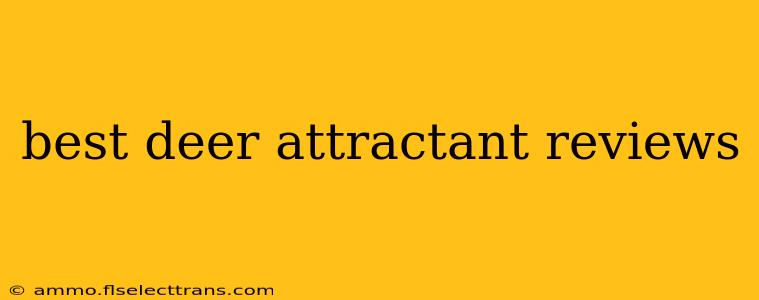Finding the best deer attractant can significantly improve your hunting success or simply enhance the wildlife viewing experience on your property. However, with a plethora of products on the market, choosing the right one can feel overwhelming. This comprehensive review guide cuts through the noise, providing in-depth analysis of top-performing deer attractants based on their ingredients, effectiveness, and user feedback.
We've scoured countless reviews and analyzed various attractant types to bring you this unbiased and informative guide. Whether you're a seasoned hunter or a backyard wildlife enthusiast, this resource will help you make an informed decision.
Types of Deer Attractants: Understanding the Options
Before diving into specific product reviews, let's explore the common types of deer attractants:
1. Mineral Supplements:
Mineral supplements provide deer with essential nutrients like calcium, phosphorus, and magnesium, often lacking in their natural diet. These attractants are particularly effective during specific seasons when natural food sources are scarce. Key benefit: Draws deer consistently over time.
2. Protein Supplements:
Protein supplements are designed to cater to deer's protein needs, especially crucial during the breeding season or when raising fawns. These often contain high-quality protein sources. Key benefit: Attracts deer quickly, ideal for short-term strategies.
3. Scent-Based Attractants:
These attractants utilize natural or synthetic scents designed to mimic deer's preferred foods or pheromones. Effective scent attractants can trigger deer's natural curiosity and feeding instincts. Key benefit: Triggers immediate response, often used during hunting season. However, the effectiveness can vary greatly depending on wind direction and other environmental factors.
4. Food Plots & Planting:
Creating food plots using deer-preferred plants like clover, alfalfa, or brassicas is a long-term strategy that provides a consistent and natural food source. While this requires more effort and planning, it offers sustainable results and attracts a large number of deer. Key benefit: Natural, consistent attraction over a long period. Requires upfront work and land management.
Top Deer Attractant Reviews: A Closer Look
While we can't endorse specific brands directly due to the ever-changing market and potential for bias, we can provide you with a framework for evaluating products. Consider the following aspects when reviewing individual deer attractants:
1. Ingredient Quality: Look for high-quality ingredients and avoid products containing fillers or artificial additives. Natural ingredients generally yield better results.
2. Scent Concentration and Longevity: A strong, long-lasting scent is crucial for attracting deer, especially over a large area.
3. Ease of Use: Consider how easy the attractant is to apply and maintain.
4. User Reviews: Pay close attention to verified user reviews on reputable platforms. Look for reviews that discuss both positive and negative experiences.
5. Price: Balance the cost with the attractant's effectiveness and longevity. A more expensive product might be worth the investment if it provides superior results.
Tips for Maximizing Deer Attractant Effectiveness
- Placement: Strategically place attractants in areas where deer are likely to travel or feed.
- Scent Dispersion: Consider using scent dispensers or strategically placing attractants to ensure optimal scent dispersal.
- Environmental Factors: Be aware of weather conditions and wind direction, as these can significantly impact the scent's effectiveness.
- Consistency: Consistent use of attractants over time is key to building a reliable feeding pattern.
- Ethical Considerations: Always adhere to local hunting regulations and ethical hunting practices when using deer attractants.
Conclusion: Choosing the Right Attractant
Selecting the best deer attractant depends on your specific needs, budget, and hunting or wildlife viewing goals. By understanding the various types of attractants and considering the factors outlined above, you can make an informed decision and enhance your wildlife experience. Remember to always consult local regulations and prioritize ethical practices.

